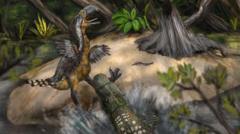The fossilized remains of a terror bird, a colossal avian predator, have unveiled a gripping tale of survival of the fittest from 13 million years ago. Scientists have discovered distinct teeth marks on the bird's leg bone, indicating that a much larger predator, likely a crocodile-like reptile known as a caiman, may have caused its demise. The research team, based in Colombia, dedicated their study to examining these marks in detail, which they believe signify a "battle to the death."
The study, published in the journal Biology Letters, involved analyzing 3D digital scans of the teeth marks and comparing them to fossils of crocodilian species. The leg bone was discovered over 15 years ago in the Tatacoa Desert, a rich fossil site from the Middle Miocene epoch, characterized by a humid landscape. During this era, the terror bird would have stood approximately 2.5 meters tall, employing its powerful beak and legs to overpower prey in its swampy habitat.
Lead researcher Andres Link from the Universidad de Los Andes in Bogotá noted that the absence of healing in the bite marks pointed to the bird's likely death during the attack: "That was the last day that bird was on this planet - then a piece of its leg bone was found 13 million years later." The researchers engaged closely with local fossil collector César Augusto Perdomo, who played a vital role in unearthing many fossils in the region.
According to the findings, the teeth marks most closely resemble those of the extinct caiman species known as Purussaurus neivensis, which could grow up to five meters long. This predator likely ambushed its prey similarly to modern-day caimans. Understanding these interactions between apex predators provides valuable insights into historical ecosystems, suggesting that terror birds may have been more vulnerable than previously believed.
Dr. Link expressed excitement about the knowledge gained from this solitary bone, emphasizing its potential to enhance our understanding of Earth's prehistoric life. Each fossil piece serves as a time capsule, offering glimpses into a world long gone.
The study, published in the journal Biology Letters, involved analyzing 3D digital scans of the teeth marks and comparing them to fossils of crocodilian species. The leg bone was discovered over 15 years ago in the Tatacoa Desert, a rich fossil site from the Middle Miocene epoch, characterized by a humid landscape. During this era, the terror bird would have stood approximately 2.5 meters tall, employing its powerful beak and legs to overpower prey in its swampy habitat.
Lead researcher Andres Link from the Universidad de Los Andes in Bogotá noted that the absence of healing in the bite marks pointed to the bird's likely death during the attack: "That was the last day that bird was on this planet - then a piece of its leg bone was found 13 million years later." The researchers engaged closely with local fossil collector César Augusto Perdomo, who played a vital role in unearthing many fossils in the region.
According to the findings, the teeth marks most closely resemble those of the extinct caiman species known as Purussaurus neivensis, which could grow up to five meters long. This predator likely ambushed its prey similarly to modern-day caimans. Understanding these interactions between apex predators provides valuable insights into historical ecosystems, suggesting that terror birds may have been more vulnerable than previously believed.
Dr. Link expressed excitement about the knowledge gained from this solitary bone, emphasizing its potential to enhance our understanding of Earth's prehistoric life. Each fossil piece serves as a time capsule, offering glimpses into a world long gone.



















